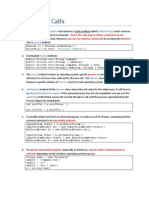Assignment Concurrent Programming
Uploaded by
Kien HawAssignment Concurrent Programming
Uploaded by
Kien HawPage 1 of 7
Concurrent Programming - CT074-3-2
Objective:
This assignment has been designed for students to apply appropriate
concurrent program design methods in designing and implementing a
concurrent program from a program specification.
Marking Criteria
The criteria used to evaluate the assignment are as follows:
Appropriateness of coding techniques used to implement design
Appropriateness of the Java concurrent programming facilities used
Program runs appropriately
Appropriateness of Class Diagram
Usefulness of instructions for compiling and running the program including comment
lines in source codes.
Presentation of the source code listings except UI-related codes
Discussion of the safety aspects of multi-threaded system implemented
Discussion of encapsulation implemented
Reporting of appropriate tests of program execution
Depth of discussion listing of section(s) that did not meet requirements and/or code
extracts of sections that met requirements.
Level 2
Critical Appraisal
Asia Pacific University of Technology & Innovation
Page 2 of 7
Concurrent Programming - CT074-3-2
Performance Criteria
1.
A demonstration of your work to the lecturer. Marks will be allocated on the basis of
your ability to deliver a coherent, clear and well-prepared verbal presentation of your
system. To achieve a mark of:
Fail: Not able to articulate and explain basic functionality of system
Pass: Your delivery must be clear, but may suffer from a lack of organisation or preparation.
Credit (Lower): As above, plus your presentation is clear, well organised and prepared.
Credit (Upper): as above, plus be able to clearly answer questions from your lecturer about
your system. Your examples cover the majority of the functionality of the system, and are
well chosen to do so.
Distinction: as above, plus the presentation must have an extra spark that makes it stand out
from the other presentations. This mark is reserved for presentations that are of an excellent
standard.
2.
Assessment of functionality. This will be assessed by your tutor experimenting with
your electronic submission. To achieve a mark of:
Fail: Your system cannot compile with the command javac *.java.
Pass: The system works properly having met basic requirements. .
Credit (Lower): As above, plus the system provided meets all expected functionality.
Credit (Upper): As above, plus the system is free from deadlock
Distinction: As above, plus the system must have an extra spark that makes it stand out from
other systems. This mark is reserved for systems that have outstanding functionality, and is
free from data corruption and deadlock.
3.
Report on Correctness. This report must provide an argument of how you know that
your system behaves correctly. To receive a mark of:
Fail: Your report cannot be easily read by your lecturer and has many missing parts.
Pass: Your report must be easily read, informally outline the particular concurrency issues
that your system faces and meet satisfactory documentation requirements (seem marking
criteria above).
Credit (Lower): As above, plus you must provide one of a test report or discussion which
shows that your system is free from data corruption and deadlock.
Credit (Upper): As above, plus you must provide discussion that shows that your system is
free from data corruption and deadlock.
Distinction: As above, plus the report must be among the best in the class, and must stand
out from the other reports in your class.
Level 2
Asia Pacific University of Technology & Innovation
Page 3 of 7
Concurrent Programming - CT074-3-2
MARKING SCHEME
Marks
Criteria
Excellent
Good
Average Poor
Very
Poor
1. Appropriateness
of
coding
techniques used to implement design
(5)
(4)
(3)
(2)
(1/0)
2. Appropriateness
of
the
Java
concurrent programming facilities
used
3. Program runs appropriately
(9-10)
(7-8)
(5-6)
(3-4)
(0-2)
(5)
(4)
(3)
(2)
(1/0)
(5)
(4)
(3)
(2)
(1/0)
4. Appropriateness of Class Diagram
SUB-TOTAL (T1)
Marks (5 marks for each criteria below)
Criteria
Excellent
(5)
Good
Average
Poor
(4)
(3)
(2)
5. Usefulness of instructions for
compiling and running the program
including comment lines in source
codes.
6. Discussion of the safety aspects of
multi-threaded system implemented
7. Discussion
of
encapsulation
implemented
8. Reporting of appropriate tests of
program execution
9. Depth of discussion listing of
section(s) that did not meet
requirements and/or code extracts of
sections that met requirements.
SUB-TOTAL (T2)
Total Marks = (T1 + T2) *2
Level 2
Asia Pacific University of Technology & Innovation
Very
Poor
(1/0)
Page 4 of 7
Concurrent Programming - CT074-3-2
Case Study
The sleepy salon
The Problem
Standing area
Standing area
Three salon chairs
ENTER
EXIT
Three hairdressers work independently in a salon shop:
The salon has 3 salon chairs, each of which is assigned to one hairdresser.
Due to budget restrictions, there are only 2 combs and 2 scissors in the
salon.
Each hairdresser follows the same work plan:
The hairdresser sleeps when no customer is waiting (and is not in the
hairdresser's own chair).
When the hairdresser is asleep, the hairdresser waits to be awakened
by a new customer. (A sign in the shop indicates which salon has been
asleep longest, so the customer will know which hairdresser to wake
up if multiple hairdressers are asleep.)
Once awake, the hairdresser cuts the hair of a customer in the
hairdresser's chair.
The hairdresser requires a comb and a pair of scissors to cut a
customers hair. When the haircut is done, the customer pays the
hairdresser and then is free to leave.
Level 2
Asia Pacific University of Technology & Innovation
Page 5 of 7
Concurrent Programming - CT074-3-2
After receiving payment, the hairdresser calls the next waiting
customer (if any). If such a customer exists, that customer sits in the
hairdresser's chair and the hairdresser starts the next haircut. If no
customer is waiting, the hairdresser goes back to sleep.
Each customer follows the following sequence of events.
When the customer first enters the salon, the customer leaves
immediately if more than 20 people are waiting (10 standing and 10
sitting). On the other hand, if the salon is not too full, the customer
enters and waits.
If at least one hairdresser is sleeping, the customer looks at a sign,
wakes up the hairdresser who has been sleeping the longest, and sits
in that hairdresser 's chair (after the hairdresser has stood up).
If all hairdressers are busy, the customer sits in a waiting-room chair,
if one is available. Otherwise, the customer remains standing until a
waiting-room chair becomes available.
Customers keep track of their order, so the person sitting the longest
is always the next customer to get a haircut.
Similarly, standing customers remember their order, so the person
standing the longest takes the next available waiting-room seat.
Deliverables:
For this exercise, you are to model the salon and write a Java program to
simulate activity for this salon:
Simulate each hairdresser and each customer as a separate process.
Altogether, 30 customers should try to enter.
Use a random number generator, so a new customer arrives every 1, 2, 3,
or 4 seconds. (This might be accomplished by an appropriate statement
sleep (1+ (rand () %4)).
Similarly, use a random number generator, so each haircut lasts between 3
and 6 seconds.
Each hairdresser should report when he/she starts each haircut and when
he/she finishes each haircut.
Each customer should report when he/she enters the salon. The customer
also should report if he/she decides to leave immediately.
Similarly, if the customer must stand or sit in the waiting room, the
customer should report when each activity begins.
Finally, the customer should report when the haircut begins and when the
customer finally exits the shop.
Level 2
Asia Pacific University of Technology & Innovation
Page 6 of 7
Concurrent Programming - CT074-3-2
Sample Output
In order to see what is happening dynamically you must have output from
the Customers and the hairdressers reporting all their major events.
Add information about which process/thread is doing the output. This way
you can see if a process/thread acts for another, which is strictly forbidden,
but is a common error for Java solutions (objects are not processes!). An
example of such incorrect behaviour is
Thread-Hairdresser: 21.31: Hairdresser1: Customer 3 is done!
main: 21.50: Hairdresser: Next customer please!
Thread-Customer-12 : 21.50: Customer12 is waiting for a chair.
Thread-Hairdresser: 21.31: Hairdresser2: Acquiring comb2!
Where you can see that not only the hairdresser thread but also the main
thread is acting for the hairdresser.
Note that realistic time stamps are not required, it is fine to use any function
to generate them.
You must not
Kill a thread or process. You may not use any of the following
primitives in Java:
o
Thread.stop
Thread.resume
Thread.suspend
Thread.interrupt
setDaemon
You may not use the destroy or stop(0) primitives in - except to take
care of temporary resources like simple timers.
If any of those primitives are found in your code, you will fail the
assignment no matter the functionality of it.
Solve the last orders problem in a manner forbidden in the description
above.
Resolve communication with an all-purpose one-channel solution.
Level 2
Asia Pacific University of Technology & Innovation
Page 7 of 7
Concurrent Programming - CT074-3-2
Tips
Run your program without customers entering the salon. This should
work if your solution is correct. The solutions should not be dependent
on the events created by the customers.
Make very sure of who's actually doing the work. Make this easier for
yourself by printing the name of the process performing an action.
The use of semaphores (other than for controlling simple resources
and basic mutex for statistics) is strongly discouraged.
Use short delay times - there is no need for a simulation run to take
more than 20-30 seconds.
You do not need to implement a ticker.
Implementation
You should implement your simulation in Java.
Caution!
It might be tempting to use the Thread.interrupt() method to wake sleeping
processes. This is a bad idea. Firstly, we have seen what a mess people can
get into with this! Secondly, a behaviour which is present in every execution
of the program is not exceptional, and is usually considered bad
programming style to use an exception in such cases. In summary, don't use
Thread.interrupt().
Documentation
The documentation should contain the following:
Structure diagram where applicable.
Requirements as seen from the marking scheme.
UML class diagram of your implementation in Java (your source code
must correspond against your UML class diagram).
Explanation on sections of codes which you spent most time (include
code extracts) on and also include discussion of section that did not
work as expected.
Other relevant discussions/diagrams.
Describe any modifications, assumptions and basic design decisions
that have been made about the behavior of the various components
of the simulation.
Level 2
Asia Pacific University of Technology & Innovation
You might also like
- Start Programming & Simulating PLC In Your Laptop from Scratch: A No BS, No Fluff, PLC Programming Volume 1: Volume, #1From EverandStart Programming & Simulating PLC In Your Laptop from Scratch: A No BS, No Fluff, PLC Programming Volume 1: Volume, #13.5/5 (4)
- Practical Monte Carlo Simulation with Excel - Part 2 of 2: Applications and DistributionsFrom EverandPractical Monte Carlo Simulation with Excel - Part 2 of 2: Applications and Distributions2/5 (1)
- 5 Assignment Concurrent Programming Depot OBE Apr 2018No ratings yet5 Assignment Concurrent Programming Depot OBE Apr 20186 pages
- Hacks To Crush Plc Program Fast & Efficiently Everytime... : Coding, Simulating & Testing Programmable Logic Controller With ExamplesFrom EverandHacks To Crush Plc Program Fast & Efficiently Everytime... : Coding, Simulating & Testing Programmable Logic Controller With Examples5/5 (1)
- CODING INTERVIEW: 50+ Tips and Tricks to Better Performance in Your Coding InterviewFrom EverandCODING INTERVIEW: 50+ Tips and Tricks to Better Performance in Your Coding InterviewNo ratings yet
- Deadline: 09 November 2021 On or Before 2359 Hours. Late Submissions Are NOT PermittedNo ratings yetDeadline: 09 November 2021 On or Before 2359 Hours. Late Submissions Are NOT Permitted12 pages
- Learn To Program, Simulate Plc & Hmi In Minutes with Real-World Examples from Scratch. A No Bs, No Fluff Practical Hands-On Project for Beginner to Intermediate: BoxsetFrom EverandLearn To Program, Simulate Plc & Hmi In Minutes with Real-World Examples from Scratch. A No Bs, No Fluff Practical Hands-On Project for Beginner to Intermediate: BoxsetNo ratings yet
- PRACTICAL GUIDE TO LEARN ALGORITHMS: Master Algorithmic Problem-Solving Techniques (2024 Guide for Beginners)From EverandPRACTICAL GUIDE TO LEARN ALGORITHMS: Master Algorithmic Problem-Solving Techniques (2024 Guide for Beginners)No ratings yet
- CIS6003 Advanced Programming: Student Details (Student Should Fill The Content)No ratings yetCIS6003 Advanced Programming: Student Details (Student Should Fill The Content)9 pages
- How to Build Self-Driving Cars From Scratch, Part 1: A Step-by-Step Guide to Creating Autonomous Vehicles With PythonFrom EverandHow to Build Self-Driving Cars From Scratch, Part 1: A Step-by-Step Guide to Creating Autonomous Vehicles With PythonNo ratings yet
- Roshan Christy Bolonne 20147455: Student Details (Student Should Fill The Content)No ratings yetRoshan Christy Bolonne 20147455: Student Details (Student Should Fill The Content)34 pages
- Programmer's Motivation for Beginners: Real Learning Stories & TipsFrom EverandProgrammer's Motivation for Beginners: Real Learning Stories & Tips5/5 (2)
- What Andon Truely is in Lean Manufacturing?: Toyota Production System ConceptsFrom EverandWhat Andon Truely is in Lean Manufacturing?: Toyota Production System Concepts5/5 (1)
- Introduction to Algorithms: A Comprehensive Guide for Beginners: Unlocking Computational ThinkingFrom EverandIntroduction to Algorithms: A Comprehensive Guide for Beginners: Unlocking Computational ThinkingNo ratings yet
- Docs - Train Timetable Scheduler 2024 CSC520No ratings yetDocs - Train Timetable Scheduler 2024 CSC52023 pages
- Final Project - Ticket Management System UpgradedNo ratings yetFinal Project - Ticket Management System Upgraded35 pages
- PPS0335 ProjectGuidelines T3 - 2015 2016No ratings yetPPS0335 ProjectGuidelines T3 - 2015 20164 pages
- Angular Performance Optimization: Everything you need to knowFrom EverandAngular Performance Optimization: Everything you need to knowNo ratings yet
- (AP CS A) Semester 1 Project (For Students)No ratings yet(AP CS A) Semester 1 Project (For Students)4 pages
- Software Testing: A Guide to Testing Mobile Apps, Websites, and GamesFrom EverandSoftware Testing: A Guide to Testing Mobile Apps, Websites, and Games4.5/5 (3)
- Save Your Time with VBA!: 5 Quality VBA Books In One Package!From EverandSave Your Time with VBA!: 5 Quality VBA Books In One Package!No ratings yet
- School of Electronics and Computer ScienceNo ratings yetSchool of Electronics and Computer Science3 pages
- Quality Assurance Testing from Beginner to Paid Professional, 1: Everything You Need to Know to Start a Career in Manual and Automated QA TestingFrom EverandQuality Assurance Testing from Beginner to Paid Professional, 1: Everything You Need to Know to Start a Career in Manual and Automated QA Testing5/5 (1)
- The Software Programmer: Basis of common protocols and proceduresFrom EverandThe Software Programmer: Basis of common protocols and proceduresNo ratings yet
- Software Testing Interview Questions You'll Most Likely Be AskedFrom EverandSoftware Testing Interview Questions You'll Most Likely Be AskedNo ratings yet
- Creating a One-Piece Flow and Production Cell: Just-in-time Production with Toyota’s Single Piece FlowFrom EverandCreating a One-Piece Flow and Production Cell: Just-in-time Production with Toyota’s Single Piece Flow4/5 (1)
- Getting Started With Quick Test Professional (QTP) And Descriptive ProgrammingFrom EverandGetting Started With Quick Test Professional (QTP) And Descriptive Programming4.5/5 (2)
- Synopsis of The Smart E-Learning Management System-4No ratings yetSynopsis of The Smart E-Learning Management System-459 pages
- RMAN Database Restore RAC - RAC - Bright DBANo ratings yetRMAN Database Restore RAC - RAC - Bright DBA52 pages
- Essential Skills For Security in Modern Application DevelopmentNo ratings yetEssential Skills For Security in Modern Application Development27 pages
- Launching An Epicor 10 Screen With Programming Code - GingerHelpNo ratings yetLaunching An Epicor 10 Screen With Programming Code - GingerHelp17 pages
- XSLT Position - How Does The XSLT Position Work With ExamplesNo ratings yetXSLT Position - How Does The XSLT Position Work With Examples18 pages
- 7183HUMAN COMPUTER INTERACTION Old Question PaperNo ratings yet7183HUMAN COMPUTER INTERACTION Old Question Paper4 pages
- Creating Simple ASP Pages: Adding Server-Side Script CommandsNo ratings yetCreating Simple ASP Pages: Adding Server-Side Script Commands11 pages

























































































